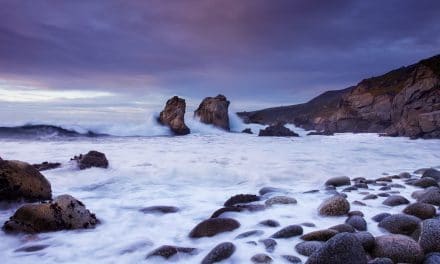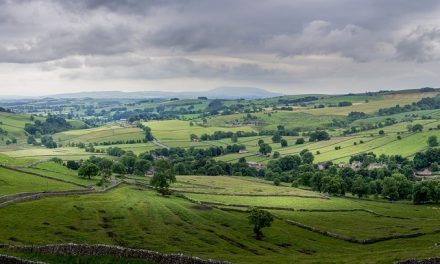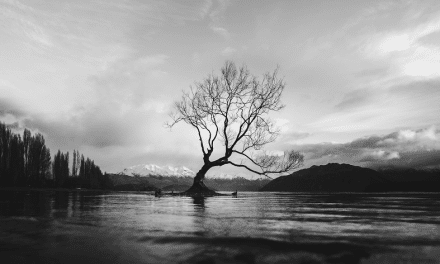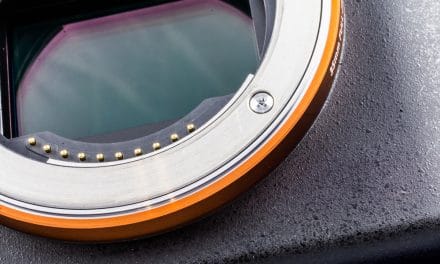Winter is a great season for landscape and nature photography, although it will present some unique challenges. If you are willing to overcome those challenges you can be rewarded with very striking and unique photographs that stand out.
Here are some tips to help you get the most out of your landscape photography during the winter months.
→ Related reading: 10 Ideas for Winter Landscape Photos
1. Be Safe
First and foremost, be sure that you are taking all the necessary safety precautions. Safety is always important for landscape photographers, especially when you are shooting in remote destinations or doing a lot of hiking or camping. But it’s even more important in winter because of the added dangers that can be present because of very cold temperatures.
Be sure to have all of the necessary clothing like a warm coat, hat, gloves, boots, and a scarf. It’s also a good idea to have some blankets in the car if you will be driving through any remote locations. Check the weather forecasts and avoid driving in areas that could be potentially dangerous.
Take a 4-wheel drive vehicle if needed.
When you are shooting your landscapes, you want to be thinking about shooting landscapes – not feeling distracted by anything else. That means you need to protect yourself from the elements, by preparing before you go out to shoot.
Make sure that you have waterproof clothing and shoes – you can easily buy cheap coats and trousers to slip on over your clothes as needed. You also need an insulating layer to guard against low temperatures and sharp winds, so thermals are a great option to keep you warm without making you feel bulky or restrained.
A hat will help keep more of your body heat inside and divert rain or snow away from your face, and gloves are a must to stop your fingers freezing up. Try gloves designed for smartphone use, which have special pads in the fingertips, to help you control the camera easily.
Don’t forget to protect your camera, too. Investing in a waterproof cover will mean you don’t have to worry about rain or snow ruining your equipment, so you can just get on with it and shoot.
2. Have the Right Gear
Winter brings it’s own gear-related challenges as well. The cold weather drains batteries faster than usual, so take some extra fully-charged batteries and try to keep them warm until you need them.
A lens hood and polarizer can help deal with an extra glare that can reflect off of the snow and ice.
It’s also a good idea to have some towels for drying off your camera when you come indoors or back to your car.
3. Set the White Balance
One of the biggest challenges of shooting in the winter is getting the right white balance. Scenes with a lot of snow can trick a camera into using the wrong white balance, so you may need to set it manually. Refer to your camera’s manual for instructions on how to set the white balance.
4. Use the Histogram
The histogram is the most helpful tool for getting your exposures right, so be sure to check it. Make sure that you are not blowing out the highlights of the snow-covered areas. You can adjust the exposure compensation as needed, based on the data from your histogram.
5. Look for Contrast
The best winter landscapes often feature a strong contrast between the white snow and dark objects or areas of the photo. You don’t want a snow-filled photo where everything in the scene is very light. When looking for scenes to capture look for areas of contrast.
6. Consider Black & White
Going black & white is a good option for winter landscapes, and it is a great way to show the contrast of the scene. Converting to black & white is something you can do during post-processing, but it’s a good habit to consider it while you’re shooting and visualize how the scene will look in black & white.
7. Use Color in Your Compositions
When composing your shots look for ways to take advantage of pops of color that may exist. The color will stand out in a snow-filled scene that includes a lot of white.
8. Use Exposure Bracketing
Because getting the right exposure can be a challenge with winter photography, bracketing your exposures can be a good idea. Check your camera’s manual for instructions to use exposure bracketing and it will help to ensure that you get a shot with the correct exposure. It will also give you the option to create HDR images if you would like.
For more on exposure bracketing please see Introduction to Exposure Bracketing & Tips for Terrific Photos.
9. Know Your Light
Did you know that snow provides some of the best possible lighting conditions that a photographer could ask for? Because it is bright white, and because it contains many smaller crystals which also reflect light, it acts almost as a fill-in light for all of your shots. During and after the snowfall, the sky also tends to be filled with an even light, which makes the reflection even stronger.
All of this means that when snow is forecast, you should be getting your camera ready. It’s a great way to incorporate some portraiture into your portfolio as well, as the light coming from all directions gives a fantastic natural setting that will flatter your model.
Other lighting considerations come into play in the winter, too. The sunsets earlier and rises later, which means you have less time to play around when traveling to a location.
Do your research on timings so you can arrive just as the sun is rising for those first golden rays of light, and plan to stay until the sunset bathes everything in orange and pink. You should also bear in mind that the available natural light may be dimmer than at other times of the year, especially if the sky is overcast.
Watch out for the weather forecast and plan to shoot on days which might hold some winter sun.
10. Prepare your equipment
Having to cut your shoot short because of an equipment malfunction will be no fun at all, so make sure that you do everything you can to stop it from happening. Especially if you are stepping into snowy conditions and freezing temperatures, there are some things that you need to do differently than normal.
One thing to be aware of is that batteries tend to discharge faster in the cold. This means you should bring extras, and try to have a warm place to put them when not in use.
If your battery dies quicker than expected, you can try holding it or putting it into a pocket close to your skin, to warm it up with your body heat.
Don’t change your lens outdoors in snowy weather, as this can bring moisture into either the lens or the body. You should also be careful about how you bring your equipment back into a warm environment. Encase them in a sealed plastic bag before you enter, and then leave them a few hours to acclimatize in a cooler area before you get them out.
Finally, invest in a waterproof container for your SD cards. The last thing you want is to drop a card in to the snow and watch all of your photos disappear into the snow.
11. Look for color
One of the challenging things about winter photography is that snow is all one color: white. In some cases, this can create a striking photograph.
However, more often than not, it can make the landscape look uninteresting and flat. So, to solve this, start training yourself to look for color.
Color can enter the equation in several ways. One way you can do it is to wake up early for the golden hour or wait for those pink and orange tones of sunlight that we discussed earlier. Those tones can reflect from the snow, creating gorgeous imagery.
Another way is to look for features in the landscape that add that color. Perhaps there is a colorful ski chalet that stands out on the mountainside, or a hiker walking by in a bright red jacket.
If the snow has fallen early, you might find color in the plant life that sticks out above that white coverage.
Even if your winter weather does not involve snow, but only rain and cold temperatures, you can still use this technique. Rainy and overcast skies tend to lend a grey palette to everything, so those pops of color and bright light will bring a focal point to the image and make it more interesting.
12. Watch your color balance
Your color balance should be changed to cool settings so that you are conveying the winter mood accurately with your images. Under a warm color balance, the image won’t look right – and it certainly won’t convey how cold you were while you were taking the shot!
Colour balance can be changed in post-production if you forget to change it in-camera. You can alter RAW files easily, but if you only have JPGs or another file format available, then it comes down to the use of filters. These will help you to convert that color temperature back to how it should be.
If you want to convey a scene that is completely washed out with snow, you can also deliberately overexpose your image – just by a couple of stops, nothing too dramatic. This will ensure that the image is as light as possible and gives this sense of the whiteout from the snow, without losing too much detail
Shooting in the winter is all about adapting to the specific circumstances that come with cold and snow. So long as you master these tips, your images should improve greatly.
10 Ideas for Winter Landscape Photos
Each season of the year brings unique opportunities, and challenges, for landscape photographers. The same scene can look drastically different throughout the year, and if you want captivating and unique photos getting out in the winter is one of the best ways to make it happen.
Not only can snow and ice add intrigue to your photos, but fewer winter photos exist for most locations, so your work will stand out.
Of course, shooting landscapes in winter requires some planning, safety precautions, and a desire to do what’s needed to get quality photographs, but then it can be well worth the effort.
In this section of the article, we’ll take a look at 10 possibilities for capturing your own unique and amazing photos during winter months.
→ Related reading: Winter Landscape Photography Tips
Mountains
Snow-covered mountains are a great subject for landscape photographers. Many high mountains are covered in snow well beyond the winter months, but winter brings the opportunity for photographers all over the world to head to a nearby mountain and capture a beautiful snow-filled scene.
→ See 10 Tips for Impressive Mountain Photography
Roads
Driving on winter roads may not be very much fun, but photographing them can be a great way to capture the winter landscape. It could be a plowed road (like the one shown below) surrounded by a snow-covered landscape or a road covered in an untouched layer of snow either during a snowstorm or before the road has been cleared.
Snow-Covered Trees
Simply photography trees covered with snow can make for some interesting photos. The photo below shows snow-covered treetops with a foggy haze that gives it a nice wintery feel. You can even opt for close-ups of branches or small sections of a tree covered in fresh snow.
Bare Trees
While autumn presents opportunities for photographing the beautiful colors of changing leaves, once those leaves have fallen you can also get nice moody photos. This is especially true when snow or ice is present to give the photo a more distinct winter look.
Frozen Lakes
Freezing or frozen bodies of water can also present photographic opportunities. Lakes make excellent subjects in any season, and in winter the scene can result is unique and beautiful photos. This doesn’t apply only to lakes. You could photograph a small pond, river, or even a waterfall in a snowy or icy setting.
Starry Skies
Winter also presents opportunities for beautiful night landscapes, especially if you are fortunate enough to be in a location where you can view the aurora borealis.
To learn how to capture beautiful night landscapes please see Collier’s Guide to Night Photography in the Great Outdoors.
Close Up Details
Snow and ice can create intriguing photos, especially when you capture the close up details. It could be snow on a tree (like the photo below). a fallen leave covered by a layer of ice, closeups of a frozen lake, the texture of a snow-covered object, or some other detail.
Include a Person in the Landscape
This option isn’t limited to just winter landscapes, but it’s worth pointing out because it can change your photos. You could include a person in the foreground, like the example below, or somewhere off in the distance to add scale and perhaps some intrigue.
Landscape photography is typically all about nature, but sometimes adding a person can make your photos stand out.
Epic Landscapes
Epic, iconic landscapes can look drastically different when covered in snow. While there are countless photos of the Grand Canyon, a very small percentage of the show this highly-recognized landscape in winter. If you want photos of iconic destinations but want yours to be unique, consider visiting during winter months.
Sunrise or Sunset
Sunrise and sunset are ideal times for nature photography any time of the year, but a winter sunrise or sunset can combine with snow or ice to look even more amazing. Also, since the days are shorter in the winter sunrise will be later than other times of the year, and sunset earlier.
Depending on your schedule and when you can easily get out for some photography, the winter sunrise and sunset times may be convenient for you.
→ Related reading: Sunrise Photography: Make Your Images Sparkle and Shine
→ Related reading: Tips for Better Sunset Photography
Winter Photography with a Chill
Spring, summer, and fall surround us with vibrance, color, and warmth. Winter brings short days, long evenings and temperatures that in some areas can be downright dangerous if not prepared.
The first few days of 2018 welcomed winter storm, Grayson, along the eastern seaboard and frigid conditions in the midwest. The deep south, even Florida experienced cold, icy conditions and some snow.
Winter days are shorter and not as colorful as our other seasons. However, the beauty and imagery that exists with the paler shades of winter rival the other season’s vibrance. So let’s bundle up, grab our gear and go take advantage of this season’s unique beauty.
For some inspiration to break out into the chill, we’ll explore examples of nature, wildlife and landscape photography. Tips on winter attire and keeping your gear in good shape are also included.
Capturing Winter’s “Whiter Shade of Pale”
Images with winter’s soft, neutral pallets soothe the eye. Lighting is softer and colors are subdued. When photographing the soft and serene, consider how the moment felt when your processing your images.
The champagne-on-ice sunset above was only ice and soft color as far as the eye could see. To maintain the gentleness of the rose-gold sunset, the saturation and clarity were slightly softened in Lightroom by pushing the sliders to the left.
A Winter Photography Walk
Bring out your widest angle lens and take a photography walk. The harsh textures, straight lines and vivid shapes above reflect winter’s bite. The frozen piers and beams cast shadows that point to the sunrise and sun flare.
To capture the starburst, the aperture setting was set to f/16. In post-processing, the clarity and contrast sliders were pushed to the right in Lightroom to further sharpen the starburst and leading lines. For tips on sunrises and starbursts: How to Make Your Images Sparkle and Shine
Cold as Ice
Photograph and share the unusual. Living in Michigan, we make the sacrifice of leaving warmth to battle extreme conditions on occasions. The frigid conditions bring frazil ice.
When it forms, it may be just for a brief day or two before the wind and volatile conditions take it away. Frazil ice looks like floating snow cones and pancakes.
With a tripod, safety gear and a partner, I made the trek to a tested area that was thick and solid. The voluminous frazil ice in Lake Michigan’s blue water and grey-blue sky made the shot worthwhile.
Note and reminder: Photographing icy conditions requires an extra set of precautions to ensure personal and gear safety. Even if you’re experienced with icy conditions, always take a partner and have an emergency plan just in case. Additionally, ice can be very misleading. Many factors can impact the strength of the ice. What may look strong and solid could be a dangerous step. Check out: Tips on Knowing When Ice is Safe.
When ice formations appear, a macro perspective provides a close look at natures’ creation of an ice sculpture.
Color My Word….Or not
Reveal the soul of nature by converting and processing bird and wildlife images in black and white. The magnificent snowy owl with his intense golden stare is one of my personal favorites.
The Before and After Moment
The weather reporter has just delivered the winter storm that’s bearing down ‘tomorrow.’ Today, take a before image. After the weather hits, capture the same scene with Mother Nature’s impact to share her story.
Sleeping Foliage and Flowers
For those of us that love our flowers, winter grows her foliage moments. What may be a dried-up weed to a passerby, maybe a special subject for the photographer, colorless weeds, dried flowers, and leaves fill the frame with texture and a promise that new foliage will return.
Preparing You & Your Gear for the Elements
When the temperatures are in the thirties and forties, it’s easy to manage. When it dips to freezing and below, it’s a different story. The shivery winds and dropping temperatures require special gear for you and special care for your equipment.
Here are a few tips that work in temps from zero to normal weather conditions. These few extra steps will keep you and your equipment healthy and ready for the next shoot.
Exposed skin protection – before the coats, gloves, and hats, start with the skin you’re in. Moisturizers, sunscreen, chapstick, eye drops are a necessary base layer to keep your skin protected from the elements and the rougher, heavier winter fabrics.
Layer it up – instead of going for the one heavy layer, wearing multiple layers that are lighter in weight making it easy to shed during the day when it warms up. Clothing with pockets that can hold camera batteries close to your person versus close to the elements will help keep their charge longer. Below freezing conditions wreak havoc on your camera batteries and cell phone too.
Gloves – there are so many choices and layering applies here too. Gloves with attached waterproof finger covers (convertible mittens) keep fingers warm in between shots. For super cold, frigid conditions, keeping a heavy set of gloves with a separate, warm liner underneath provides flexibility when you need to take your shooting hand out quickly but with some protection.
Shoe spikes or yak tracks – if shooting on icy conditions, stability can be easily compromised within a fraction of a second. Don’t take your safety or ability to ‘handle the ice’ for granted. Attach spikes or tracks to your shoes to help prevent falling and damaging you and/or your equipment.
Patience
After shooting in the elements, wipe down and dry your gear before placing it back into your bag. Give your camera gear (and you) time to warm back up in the bag once inside. The fast temperature change can cause condensation to form inside and outside of your camera.
Winter photography has a special place in my heart. Maybe it’s because I live in the Northern Hemisphere near the 45th parallel. A recent afternoon was spent shooting in 8 degrees with a chill factor of -13 degrees. Some may call this crazy. I like to think of it as creative inspiration infused by winter’s chill.
Winter Landscape Photography: Amazing Examples
Winter is a challenging season for landscape photographers, but the snow-covered landscape can lead to powerful photographs. While spring, summer, and certainly autumn tend to get more attention, winter is a season that should not be ignored. Hopefully, this showcase will provide you with some ideas that can be used in your winter photography.
→ Related reading: Winter Landscape Photography Tips
Get Out and Experiment!
Like any type of photography, the best way to master winter landscapes is to get practice. Set aside sometime this winter to get out and photograph the nature around you.
Photo license links: CC BY 3.0, CC BY 2.0, CC BY-ND 3.0, CC BY-ND 2.0, CC BY-SA 2.0
























































